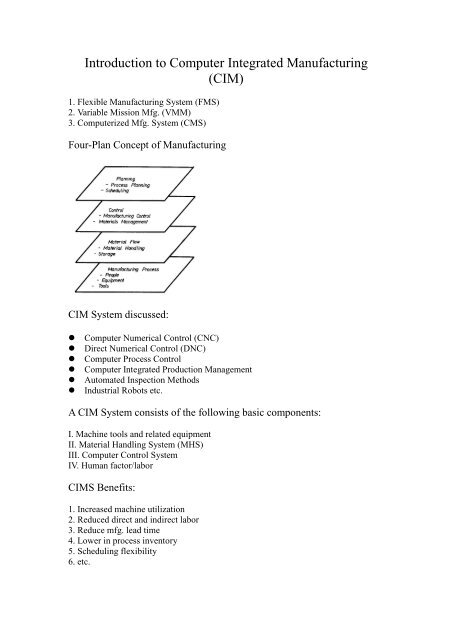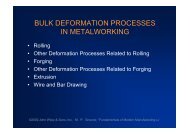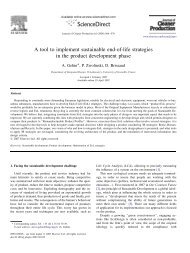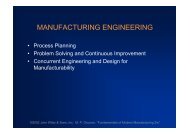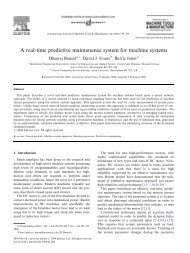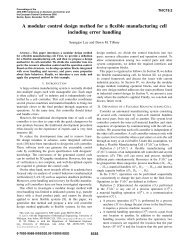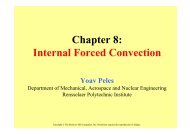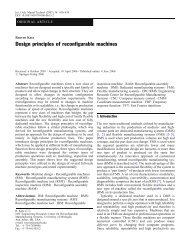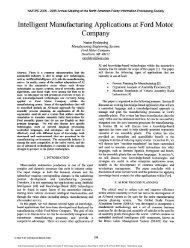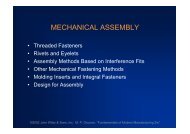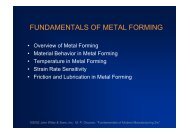Introduction to Computer Integrated Manufacturing (CIM)
Introduction to Computer Integrated Manufacturing (CIM)
Introduction to Computer Integrated Manufacturing (CIM)
Create successful ePaper yourself
Turn your PDF publications into a flip-book with our unique Google optimized e-Paper software.
<strong>CIM</strong> refers <strong>to</strong> a production system that consists of:1. A group of NC machines connected <strong>to</strong>gether by2. An au<strong>to</strong>mated materials handling system3. And operating under computer controlWhy <strong>CIM</strong>S?In Production SystemsProductionVolumn(part/yr)15,000TransferLines<strong>CIM</strong> System15Stand AloneNC Machine1. Transfer Lines: is very efficient when producing "identical" parts in largevolumes at high product rates.2. Stand Alone: NC machine: are ideally suited for variations in work partconfiguration.In <strong>Manufacturing</strong> Systems:Part Variety (# of different parts)ProductionVolumn(part/yr)15,000SpecialSystemFlexible<strong>Manufacturing</strong>System15ManfuacturingCell2100800Part Variety (# of different parts)1. Special Mfg. System: the least flexible <strong>CIM</strong> system. It is designed <strong>to</strong> produce a
very limited number of different parts (2 - 8).2. Mfg. Cell: the most flexible but generally has the lowest number of different partsmanufactured in the cell would be between 40 - 80. Annual production rates roughfrom 200 - 500.3. Flexible Mfg. System: A typical FMS will be used <strong>to</strong> process several part familieswith 4 <strong>to</strong> 100 different part numbers being the usual case.General FMSConventional Approaches <strong>to</strong> <strong>Manufacturing</strong>Conventional approaches <strong>to</strong> manufacturing have generally centered around machineslaid out in logical arrangements in a manufacturing facility. These machine layoutsare classified by:1. Function - Machines organized by function will typically perform the samefunction, and the location of these departments relative <strong>to</strong> each other is normallyarranged so as <strong>to</strong> minimize interdepartmental material handling. Workpieceproduced in functional layout departments and fac<strong>to</strong>ries are generally manufacturedin small batches up <strong>to</strong> fifty pieces (a great variety of parts).2. Line or flow layout - the arrangement of machines in the part processing order orsequence required. A transfer line is an example of a line layout. Parts progressivelymove from one machine <strong>to</strong> another in a line or flow layout by means of a rollerconveyor or through manual material handling. Typically, one or very few differentparts are produced on a line or flow type of layout, as all parts processed require thesame processing sequence of operations. All machining is performed in onedepartment, thereby minimizing interdepartmental material handling.
IV. Functions of the computer in a manufacturing organizationV. Functions of <strong>Computer</strong> in <strong>CIM</strong>S1. Machine Control –CNCNCProgrammingMicro <strong>Computer</strong>(Software Function&NC Program S<strong>to</strong>rage)Hardware(interface&Servo)FeedbackMachineCenter
2. Direct Numerical Control (DNC) - A manufacturing system in which a number ofm/c are controlled by a computer through direct connection & in real time.Consists of 4 basic elements:• Central computer• Bulk memory (NC program s<strong>to</strong>rage)• Telecommunication line• Machine <strong>to</strong>ols (up <strong>to</strong> 100)Central<strong>Computer</strong>Bulk memory(NC Program)sends instructions & relieves data (ethernet)SatellitMinicomputerBulkmemoryTele-Communication Linesm/cm/cUp <strong>to</strong> 100 m/c <strong>to</strong>ols3. Production Control - This function includes decision on various parts on<strong>to</strong> thesystem.Decision are based on:• red production rate/day for the various parts• Number of raw work parts available• Number of available pallets4. Traffic & Shuttle Control - Refers <strong>to</strong> the regulations of the primary & secondarytransportation systems which moves parts between workstation.5. Work Handling System Moni<strong>to</strong>ring - The computer must moni<strong>to</strong>r the status ofeach cart & /or pallet in the primary & secondary handling system.6. Tool Control• Keeping track of the <strong>to</strong>ol at each station• Moni<strong>to</strong>ring of <strong>to</strong>ol life7. System Performance Moni<strong>to</strong>ring & Reporting - The system computer can beprogrammed <strong>to</strong> generate various reports by the management on systemperformance.• Utilization reports - summarize the utilization of individual workstation as wellas overall average utilization of the system.• Production reports - summarize weekly/daily quantities of parts produced froma <strong>CIM</strong>S (comparing scheduled production vs. actual production)• Status reports - instantaneous report "snapshot" of the present conditions of the<strong>CIM</strong>S.• Tool reports - may include a listing of missing <strong>to</strong>ol, <strong>to</strong>ol-life status etc.
8. <strong>Manufacturing</strong> data base• Collection of independent data bases• Centralized data base• Interfaced data base• Distributed data baseProduction StrategyThe production strategy used by manufacturers is based on several fac<strong>to</strong>rs; the twomost critical are cus<strong>to</strong>mer lead time and manufacturing lead time.Cus<strong>to</strong>mer lead time identifies the maximum length of time that a typical cus<strong>to</strong>mer iswilling <strong>to</strong> wait for the delivery of a product after an order is placed.<strong>Manufacturing</strong> lead time identifies the maximum length of time between the receipt ofan order and the delivery of a finished product.<strong>Manufacturing</strong> lead time and cus<strong>to</strong>mer lead time must be matched. For example,when a new car with specific options is ordered from a dealer, the cus<strong>to</strong>mer is willing<strong>to</strong> wait only a few weeks for delivery of the vehicle. As a result, au<strong>to</strong>motivemanufacturers must adopt a production strategy that permits the manufacturinglead-time <strong>to</strong> match the cus<strong>to</strong>mer's needs.The production strategies used <strong>to</strong> match the cus<strong>to</strong>mer and manufacturer lead times aregrouped in<strong>to</strong> four categories:1. Engineer <strong>to</strong> order (ETO)2. Make <strong>to</strong> order (MTO)3. Assemble <strong>to</strong> order (ATO)4. Make <strong>to</strong> s<strong>to</strong>ck (MTS)Engineer <strong>to</strong> OrderA manufacturer producing in this category has a product that is either in the first stageof the life-cycle curve or a complex product with a unique design produced insingle-digit quantities. Examples of ETO include construction industry products(bridges, chemical plants, au<strong>to</strong>motive production lines) and large products withspecial options that are stationary during production (commercial passenger aircraft,ships, high-voltage switchgear, steam turbines). Due <strong>to</strong> the nature of the product, thecus<strong>to</strong>mer is willing <strong>to</strong> accept a long manufacturing lead time because the engineeringdesign is part of the process.Make <strong>to</strong> OrderThe MTO technique assumes that all the engineering and design are complete and theproduction process is proven. Manufacturers use this strategy when the demand is
unpredictable and when the cus<strong>to</strong>mer lead-time permits the production process <strong>to</strong> star<strong>to</strong>n receipt of an order. New residential homes are examples of this production strategy.Some outline computer companies make personal computer <strong>to</strong> cus<strong>to</strong>mer specifications,so they followed MTO specifications.Assemble <strong>to</strong> OrderThe primary reason that manufacturers adopt the ATO strategy is that cus<strong>to</strong>mer leadtime is less than manufacturing lead time. An example from the au<strong>to</strong>motive industrywas used in the preceding section <strong>to</strong> describe this situation for line manufacturingsystems. This strategy is used when the option mix for the products can be forecaststatistically: for example, the percentage of four-door versus two-door au<strong>to</strong>mobilesassembled per week. In addition, the subassemblies and parts for the final product arecarried in a finished components inven<strong>to</strong>ry, so the final assembly schedule isdetermined by the cus<strong>to</strong>mer order. John Deere and General Mo<strong>to</strong>rs are examples ofcompanies using this production strategy.Make <strong>to</strong> S<strong>to</strong>ckMTS, is used for two reasons: (1) the cus<strong>to</strong>mer lead time is less than themanufacturing lead time, (2) the product has a set configuration and few options sothat the demand can be forecast accurately. If positive inven<strong>to</strong>ry levels (the s<strong>to</strong>re shelfis never empty) for a product is an order-winning criterion, this strategy is used. Whenthis order-winning criterion is severe, the products are often s<strong>to</strong>cked in distributionwarehouses located in major population centers. This option is often the last phase ofa product's life cycle and usually occurs at maximum production volume.<strong>Manufacturing</strong> Enterprise (Organization)• In most manufacturing organizations the functional blocks can be found as:• A <strong>CIM</strong> implementation affects every part of an enterprise; as a result, everyblock in the organizational model is affected.
Sales and Promotion• The fundamental mission of sales and promotion (SP) is <strong>to</strong> create cus<strong>to</strong>mers.To achieve this goal, nine internal functions are found in many companies: sales,cus<strong>to</strong>mer service, advertising, product research and development, pricing,packaging, public relations, product distribution, and forecasting.sales and promotion interfaces with several other areas in the business:• The cus<strong>to</strong>mer services interface supports three major cus<strong>to</strong>mer functions:order entry, order changes, and order shipping and billing. The order changeinterface usually involves changes in product specifications, change inproduct quantity (ordered or available for shipment), and shipment dates andrequirements.• Sales and marketing provide strategic and production planning information <strong>to</strong>the finance and management group, product specification and cus<strong>to</strong>merfeedback information <strong>to</strong> product design, and information for masterproduction scheduling <strong>to</strong> the manufacturing planning and control group.Product/Process Definition Engineering• The unit includes product design, production engineering, and engineeringrelease.• The product design provides three primary functions: (1) product design andconceptualization, (2) material selection, and (3) design documentation.• The production engineering area establishes three sets of standards: work,process, and quality.• The engineering release area manages engineering change on everyproduction part in the enterprise. Engineering release has the responsibility ofsecuring approvals from departments across the enterprise for changes madein the product or production process.<strong>Manufacturing</strong> Planning and Control (MPC)• The manufacturing planning and control unit has a formal data andinformation interface with several other units and departments in theenterprise.• The MPC unit has responsibility for:1. Setting the direction for the enterprise by translating the managementplan in<strong>to</strong> manufacturing terms. The translation is smooth iforder-winning criteria were used <strong>to</strong> develop the management plan.2. Providing detailed planning for material flow and capacity <strong>to</strong> supportthe overall plan.3. Executing these plans through detailed shop scheduling and purchasingaction.MPC Model for Information Flow
Shop Floor• Shop floor activity often includes job planning and reporting, materialmovement, manufacturing process, plant floor control, and quality control.• Interfaces with the shop floor unit are illustrated.
Support Organization• The support organizations, indicated vary significantly from firm <strong>to</strong> firm.• The functions most often included are security, personnel, maintenance,human resource development, and computer services.• Basically, the support organization is responsible for all of the functions notprovided by the other model elements.Production Sequence :one possibility for the flow required <strong>to</strong> bring a product <strong>to</strong> acus<strong>to</strong>mer


